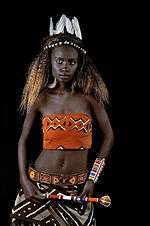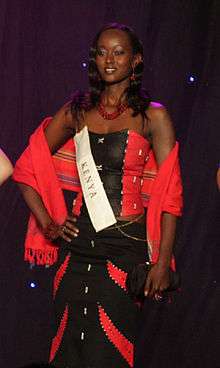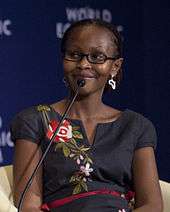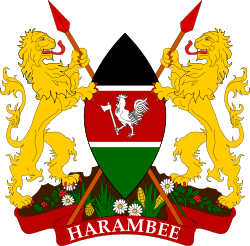Women in Kenya
| |||||||
| Gender Inequality Index[1] | |||||||
|---|---|---|---|---|---|---|---|
| Value | 0.548 (2013) | ||||||
| Rank | 122nd out of 152 | ||||||
| Maternal mortality (per 100,000) | 360 (2010) | ||||||
| Women in parliament | 19.9% (2013) | ||||||
| Females over 25 with secondary education | 25.3% (2012) | ||||||
| Women in labour force | 62.0% (2012) | ||||||
| Global Gender Gap Index[2] | |||||||
| Value | 0.6803 (2013) | ||||||
| Rank | 78th out of 144 | ||||||
The history of the evolution of the traits of women in Kenya can be divided into Women within Swahili culture, Women in British Kenya, and Kenyan Women post-Independence.[3]
Inside Swahili culture
Kenyan women who lived during the Pre-Colonial Era in Kenya were women who existed prior to 1890, which is the period before the arrival of British colonizers. The main functions of women, young and old, were related to farming, child care, maintenance of the household, market vendors, and caring for their husbands, if married.[3]
During British Kenya (1890-1963)
Kenyan women who lived during the period when Kenya was a colony of Britain existed from 1890 to 1963. These women lived in family units that, due to the influence of British colonial institutions, became patriarchal in structure and when cash-crop cultivation were controlled by men.[3]
Missionary opposition to female circumcision
Between 1929–1932, British Protestant missionaries campaigned against the practice of female genital mutilation (FGM), and were met with resistance by the Kikuyu people, Kenya's largest tribe.[4] Lynn M. Thomas, an American historian, writes that during the female circumcision controversy, the issue of FGM became a focal point of the independence movement against British colonial rule, and a test of loyalty—either to the Christian churches of the missionaries, or to the Kikuyu Central Association, the association of the Kikuyu people.[4]
Independent Kenya (1963-)
During the Post-Colonial period, women in Kenya continued to live in a society that has a patriarchal order. When Kenya gained independence in 1963, a few young women were able to attain education because of parents who became involved in religious mission activities since the Colonial era. Many of those who were not able to obtain education in schools, even those who were only 12 years old, were "married off". After 1995, due to the Beijing Platform for Action, many Kenyan women have benefited from the introduction of feminist point of views such as "female consciousness", "confidence as women", "gender equality" and justice for women. Many Kenyan women soon became active participants in Kenyan politics.[3]
Polygamy in Kenya
In March 2014, Kenya's Parliament passed a bill allowing men to marry multiple wives.[5] Polygamy is common among traditional communities in Kenya, as well as among the country’s Muslim community.[5]
In parliament, the proposed 2014 polygamy bill had initially given a wife the right to veto the husband's choice, but male members of parliament overcame party divisions to push through a text that dropped this clause.[5] The passing of the bill caused angry female members of parliament to storm out of the late night vote on the polygamy legislation in protest.[5]
See also
References
- ↑ "Table 4: Gender Inequality Index". United Nations Development Programme. Retrieved 7 November 2014.
- ↑ "The Global Gender Gap Report 2013" (PDF). World Economic Forum. pp. 12–13.
- 1 2 3 4 Gatwiri Kariuki, Claris. "WOMEN PARTICIPATION IN THE KENYAN SOCIETY" (PDF). Issue 296 December 22– 28, 2010. The African Executive. Retrieved 5 November 2013.
- 1 2 Thomas, Lynn M. "'Ngaitana (I will circumcise myself)': Lessons from Colonial Campaigns to Ban Excision in Meru, Kenya", in Shell-Duncan, Bettina and Hernlund, Ylva (eds). Female "Circumcision" in Africa. Lynne Rienner, 2000, p. 129ff.
- 1 2 3 4 "Kenya's parliament passes bill allowing polygamy", The Guardian, 22 March 2014.
External links
| Wikimedia Commons has media related to Women of Kenya. |
- HISTORY OF FEMINISM IN KENYA
- Kenya: The War on Kenyan Women by Ann Njogu, 30 January 2009
- National Council of Women of Kenya by Alistair Boddy-Evans
- AFRICAN WOMANHOOD IN COLONIAL KENYA, 1900–1950 — 2000 by Tabitha Kanogo
- Gender Equity Issues in Kenya
- The history of women and gender in Kenya
- Personalities, Kenya History — Makers of a Nation







